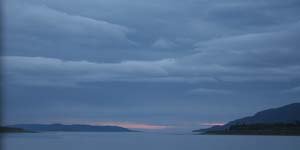3. Waiting for new food
For weeks now, his mother is dividing the available food into smaller and even smaller portions. His stomach tickles because he’s hungry. There’s almost nothing left, only six mussels and a small piece of cormorant to eat. There are also dried mushrooms but these are only for emergencies – although Sisoi believes it is an emergency case now. However, they are kept a little longer. They take good care of them because if the fire becomes extinct, dried grass or dried mushrooms will be needed to light it again. Fire is very important in Tierra del Fuego.
In winter the water thickens by the cold. But because the temperature of water is always a bit higher than on the continent of Patagonia, in this maritime environment the conditions are a little warmer. Out here the sea never freezes completely. However, the cold is unpleasant. Ice floes are floating by. The cold and cutting wind comes from the south, the icy Antarctica. The wind blows impetuous and hard. Very hard.
 In hopes of a better climate, three families with their canoes are forced to stay on one of the beaches of the island Hoste. It is too windy to go off to the sea and embark on a new journey; the waves are too wild. They will leave as soon as the worst of the storm has passed, Sisoi knows. He has already experienced some seasons like this and remembers last year, when his father taught him how to fish.
In hopes of a better climate, three families with their canoes are forced to stay on one of the beaches of the island Hoste. It is too windy to go off to the sea and embark on a new journey; the waves are too wild. They will leave as soon as the worst of the storm has passed, Sisoi knows. He has already experienced some seasons like this and remembers last year, when his father taught him how to fish.
His father on the forepart of the canoe, his mum paddling and steering. Sisoi stares at the small fire in the center of the hut. It keeps him and his parents warm. It seems that among the flames there are figures dancing. They want to tell him a story …
- Click on the ‘Yagán Martin Gusinde Museum Book’ or ‘Martin Gusinde Museum Publications‘ for in depth information.
- Would you like to continue writing on this story? Would you like to make a drawing or create a photo about this story? Send it to my e-mail and I will post it on your behalf on the website.
- Or continue reading. Next story: 4. The underwater forest
